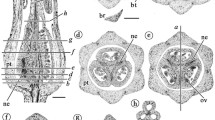Abstract
The floral ontogeny and anatomy ofKoelreuteria paniculata have been investigated to understand the developmental basis for the occurring monosymmetry and the origin of the septal cavities. Petals arise sequentially and one petal is missing between sepals 3 and 5, or rarely between sepals 2 and 5. The eight stamens arise sequentially before petal initiation is completed. The last formed petal and one stamen arise on a common primordium. Two stamen positions are empty (opposite the petal between the sepals 2 and 5, and the petal between sepal 1 and 3); consequently two antesepalous stamens have become displaced. The derivation of octandry from a diplostemonous ancestry, and reduction of the petal are discussed. The triangular gynoecium has a strong impact in obliquely reorganizing the symmetry of the flower, loss of organs, and shifts of stamens. The so-called septal slits occurring within the style are a deepreaching non-nectariferous extension of the stigma. Alternating locular furrows are present which could play a role as pollen transmitting tissue and in the loculicid dehiscence of the capsule.
Similar content being viewed by others
References
Angiosperm Phylogeny Group (1998) An ordinal classification for the families of flowering plants. Ann. Missouri Bot. Gard. 85: 531–553.
Baum H. (1950a) Septalspalten im Gynözeum vonKoelreuteria paniculata. Österr. Bot. Z. 97: 207–215.
Baum H. (1950b) Das Narbensekret vonKoelreuteria paniculata. Österr. Bot. Z. 97: 517–519.
Beille C. (1901) Recherches sur le développement floral des Disciflores. Actes Soc. Linn. Bordeaux 56: 235–410.
Corner E. J. H. (1976) The seeds of dicotyledons. 2 vols. Cambridge University Press, Cambridge.
Cronquist A. (1981) The evolution and classification of flowering plants. Columbia University Press, New York.
Daumann E. (1974) Zur Frage nach dem Vorkommen eines Septalnektariums bei Dicotyledonen. Zugleich ein Beitrag zur Blütenmorphologie und Bestäubungsökologie vonBuxus L. undCneorum L. Preslia 42: 97–109.
Dickson A. (1865) On diplostemonous flowers; with some remarks upon the position of the carpels in the Malvaceae. Trans. Bot. Soc. Edinburgh 8: 86–107.
Eichler A. W. (1878) Blüthendiagramme II. W. Engelmann, Leipzig.
Endress P. K. (1994) Diversity and evolutionary biology of tropical flowers. Cambridge University Press, Cambridge.
Igersheim A., Endress P. K. (1997) Gynoecium diversity and systematics of the paleoherbs. Bot. J. Linn. Soc. 127: 289–370.
Judd W. S., Sanders R. W., Donoghue M. J. (1994) Angiosperm family pairs: preliminary phylogenetic analyses. Harvard Pap. Bot. 5: 1–51.
Krüssmann G. (1985) Manual of cultivated broadleaved trees and shrubs vol. 2. English translation 1985. Timber Press, Oregon.
Mabberley D. J. (1987) The plant book. 1st edn. Cambridge University Press, Cambridge.
Melchior H. (1964) Engler's Syllabus der Pflanzenfamilien. Ed. 12, 2. Gebr. Borntraeger, Berlin.
Payer J. B. (1857) Traité d'organogénie comparée de la fleur. Victor Masson, Paris.
Radlkofer L. (1897) Sapindaceae. In: Engler A., Prantl K. (eds.) Die natürlichen Pflanzenfamilien III, 5. W. Engelmann, Berlin, pp. 277–366.
Ronse Decraene L. P., Smets E. (1994) Merosity in flowers: definition, origin, and taxonomic significance. Plant Syst. Evol. 191: 83–104.
Ronse Decraene L. P., Smets E. F. (1995) The distribution and systematic relevance of the androecial character oligomery. Bot. J. Linn. Soc. 118: 193–247.
Ronse Decraene L. P., Clinckemaillie D., Smets E. F. (1993) Stamen-petal complexes in Magnoliatae. Bull. Jard. Bot. Natl. Belg. 62: 97–112.
Ronse Decraene L. P., Vanvinckenroye P., Smets E. F. (1997) A study of floral morphological diversity inPhytolacca (Phytolaccaceae) based on early floral ontogeny. Int. J. Plant Sci. 158: 57–72.
Ronse Decraene L. P., De Laet J., Smets E. F. (1998) Floral development and anatomy ofMoringa oleifera (Moringaceae): what is the evidence for a capparalean or sapindalean affinity? Ann. Bot. 82: 273–284.
Schmid R. (1985) Functional interpretations of the morphology and anatomy of septal nectaries. Acta Bot. Neerl. 34: 125–128.
Smets E. F. (1988a) La présence des “nectaria persistentia” chez les Magnoliophytina (angiospermes). Candollea 43: 709–716.
Smets E. F. (1988b) Florale nektariën van de Magnoliophytina: karakterizering en systematische betekenis. Unpublished doctoral thesis, Katholieke Universiteit Leuven, Belgium.
Smets E. F., Cresens E. M. (1988) Types of floral nectaries and the concepts “character” and “character-state” — a reconsideration. Acta Bot. Neerl. 37: 121–128.
Smets E. F., Ronse Decraene L. P., Clinckemaillie D. (1991) Gynoecial development and nectaries inKoelreuteria paniculata (Sapindaceae). 11th Symposium Morphologie, Anatomie und Systematik Göttingen, abstracts: 66.
Smets E. F., Ronse Decraene L. P., Caris P., Rudall P. (in press) Floral nectaries in monocotyledons: distribution and evolution. In: Wilson K. L., Morrison D. (eds.) Systematics and evolution of Monocots. Sydney (Australia).
Traveset A. (1995) Reproductive ecology ofCneorum tricoccon L. (Cneoraceae) in the Balearic Islands. Bot. J. Linn. Soc. 117: 221–232.
Tucker S. C. (1984) Unidirectional organ initiation in leguminous flowers. Am. J. Bot. 71: 1139–1148.
Van Der Pijl (1957) On the arilloids ofNephelium, Euphoria, Litchi andAesculus, and the seeds of Sapindaceae in general. Acta. Bot. Neerl. 6: 618–641.
Van Heel W. A. (1988) On the development of some gynoecia with septal nectaries. Blumea 33: 477–504.
Weberling F. (1989) Morphology of flowers and inflorescences. Cambridge University Press, Cambridge.
Wijnands D. O. (1991)Koelreuteria. Bull. Bot. Tuin Wageningen 26: 10–11. (in Dutch)
Author information
Authors and Affiliations
Rights and permissions
About this article
Cite this article
Decraene, L.P.R., Smets, E. & Clinckemaillie, D. Floral ontogeny and anatomy inKoelreuteria with special emphasis on monosymmetry and septal cavities. Pl Syst Evol 223, 91–107 (2000). https://doi.org/10.1007/BF00985329
Received:
Accepted:
Issue Date:
DOI: https://doi.org/10.1007/BF00985329




